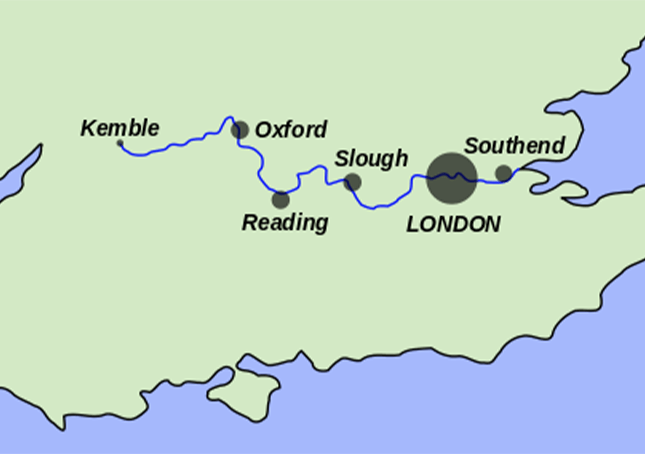River Thames

The River Thames (/tɛmz/ (About this soundlisten) TEMZ), known alternatively in parts as the River Isis, is a river that flows through southern England including London. At 215 miles (346 km), it is the longest river entirely in England and the second-longest in the United Kingdom, after the River Severn.
It flows through Oxford (where it is called the Isis), Reading, Henley-on-Thames and Windsor. The lower reaches of the river are called the Tideway, derived from its long tidal reach up to Teddington Lock. It rises at Thames Head in Gloucestershire, and flows into the North Sea via the Thames Estuary. The Thames drains the whole of Greater London.
Its tidal section, reaching up to Teddington Lock, includes most of its London stretch and has a rise and fall of 23 feet (7 m). Running through some of the driest parts of mainland Britain and heavily abstracted for drinking water, the Thames’ discharge is low considering its length and breadth: the Severn has a discharge almost twice as large on average despite having a smaller drainage basin. In Scotland, the Tay achieves more than double the Thames’ average discharge from a drainage basin that is 60% smaller.
Along its course are 45 navigation locks with accompanying weirs. Its catchment area covers a large part of south-eastern and a small part of western England; the river is fed by at least 50 named tributaries. The river contains over 80 islands. With its waters varying from freshwater to almost seawater, the Thames supports a variety of wildlife and has a number of adjoining Sites of Special Scientific Interest, with the largest being in the remaining parts of the North Kent Marshes and covering 5,449 hectares (13,460 acres).
The Thames, from Middle English Temese, is derived from the Brittonic Celtic name for the river, Tamesas (from *tamēssa),[3] recorded in Latin as Tamesis and yielding modern Welsh Tafwys “Thames”. The name may have meant “dark” and can be compared to other cognates such as Russian темно (Proto-Slavic *tĭmĭnŭ), Lithuanian tamsi “dark”, Latvian tumsa “darkness”, Sanskrit tamas and Welsh tywyll “darkness” (Proto-Celtic *temeslos) and Middle Irish teimen “dark grey”.[3] The origin is shared by many other river names in Britain, such as the River Tamar at the border of Devon and Cornwall, several rivers named Tame in the Midlands and North Yorkshire, the Tavy on Dartmoor, the Team of the North East, the Teifi and Teme of Wales, the Teviot in the Scottish Borders and a Thames tributary the Thame.
Kenneth H. Jackson has proposed that the name of the Thames is not Indo-European (and of unknown meaning),[4] while Peter Kitson suggested that it is Indo-European but originated before the Celts and has a name indicating “muddiness” from a root *tā-, ‘melt’.
Indirect evidence for the antiquity of the name ‘Thames’ is provided by a Roman potsherd found at Oxford, bearing the inscription Tamesubugus fecit (Tamesubugus made [this]). It is believed that Tamesubugus’ name was derived from that of the river. Tamese was referred to as a place, not a river in the Ravenna Cosmography (c. AD 700).
The river’s name has always been pronounced with a simple t /t/; the Middle English spelling was typically Temese and the Brittonic form Tamesis. A similar spelling from 1210, “Tamisiam” (the accusative case of “Tamisia”, see Kingston upon Thames#Early history), is found in the Magna Carta.
